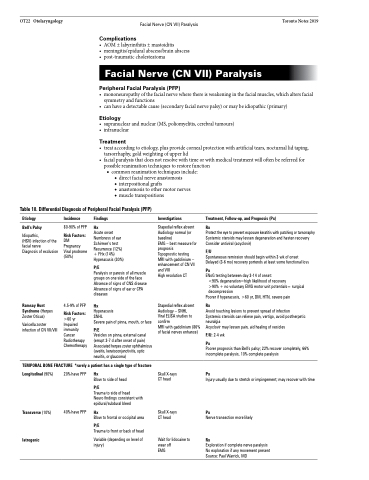Page 1008 - TNFlipTest
P. 1008
OT22 Otolaryngology
Facial Nerve (CN VII) Paralysis
Toronto Notes 2019
Complications
• AOM±labyrinthitis±mastoiditis
• meningitis/epiduralabscess/brainabscess • post-traumaticcholesteatoma
Facial Nerve (CN VII) Paralysis
Peripheral Facial Paralysis (PFP)
• mononeuropathyofthefacialnervewherethereisweakeninginthefacialmuscles,whichaltersfacial symmetry and functions
• canhaveadetectablecause(secondaryfacialnervepalsy)ormaybeidiopathic(primary)
Etiology
• supranuclearandnuclear(MS,poliomyelitis,cerebraltumours) • infranuclear
Treatment
• treataccordingtoetiology,plusprovidecornealprotectionwithartificialtears,nocturnallidtaping, tarsorrhaphy, gold weighting of upper lid
• facialparalysisthatdoesnotresolvewithtimeorwithmedicaltreatmentwilloftenbereferredfor possible reanimation techniques to restore function
Table 10. Differential Diagnosis of Peripheral Facial Paralysis (PFP)
■ common reanimation techniques include: ◆ direct facial nerve anastomosis
◆ interpositional grafts
◆ anastomosis to other motor nerves
◆ muscle transpositions
Etiology
Bell’s Palsy
Idiopathic,
(HSV) infection of the facial nerve
Diagnosis of exclusion
Ramsay Hunt Syndrome (Herpes Zoster Oticus)
Varicella zoster infection of CN VII/VIII
Incidence
80-90% of PFP
Risk Factors:
DM Pregnancy Viral prodrome (50%)
4.5-9% of PFP
Risk Factors:
>60 yr Impaired immunity Cancer Radiotherapy Chemotherapy
Findings
Hx
Acute onset Numbness of ear Schirmer’s test Recurrence (12%) + FHx (14%) Hyperacusis (30%)
P/E
Paralysis or paresis of all muscle groups on one side of the face Absence of signs of CNS disease Absence of signs of ear or CPA diseases
Hx
Hyperacusis
SNHL
Severe pain of pinna, mouth, or face
P/E
Vesicles on pinna, external canal (errupt 3-7 d after onset of pain) Associated herpes zoster ophthalmicus (uveitis, keratoconjunctivitis, optic neuritis, or glaucoma)
Investigations
Stapedial reflex absent Audiology normal (or baseline)
EMG – best measure for prognosis
Topognostic testing MRI with gadolinium – enhancement of CN VII and VIII
High resolution CT
Stapedial reflex absent Audiology – SNHL Viral ELISA studies to confirm
MRI with gadolinium (86% of facial nerves enhance)
Skull X-rays CT head
Skull X-rays CT head
Wait for lidocaine to wear off
EMG
Treatment, Follow-up, and Prognosis (Px)
Rx
Protect the eye to prevent exposure keratitis with patching or tarsorraphy Systemic steroids may lessen degeneration and hasten recovery Consider antiviral (acyclovir)
F/U
Spontaneous remission should begin within 3 wk of onset Delayed (3-6 mo) recovery portends at least some functional loss
Px
ENoG testing between day 3-14 of onset:
<90% degeneration=high likelihood of recovery
>90% + no voluntary EMG motor unit potentials= surgical decompression
Poorer if hyperacusis, >60 yr, DM, HTN, severe pain
Rx
Avoid touching lesions to prevent spread of infection Systemic steroids can relieve pain, vertigo, avoid postherpetic neuralgia
Acyclovir may lessen pain, aid healing of vesicles
F/U: 2-4 wk
Px
Poorer prognosis than Bell’s palsy; 22% recover completely, 66% incomplete paralysis, 10% complete paralysis
Px
Injury usually due to stretch or impingement; may recover with time
Px
Nerve transection more likely
Rx
Exploration if complete nerve paralysis No exploration if any movement present Source: Paul Warrick, MD
TEMPORAL BONE FRACTURE *rarely a patient has a single type of fracture
Longitudinal (90%)
Transverse (10%)
Iatrogenic
20% have PFP
40% have PFP
Hx
Blow to side of head
P/E
Trauma to side of head
Neuro findings consistent with epidural/subdural bleed
Hx
Blow to frontal or occipital area
P/E
Trauma to front or back of head
Variable (depending on level of injury)


